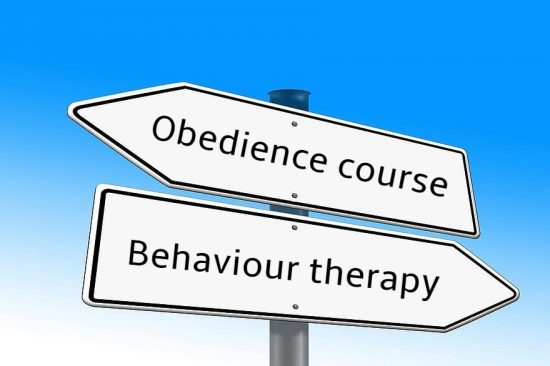Written by dog behaviourist, dog trainer and zoologist Laure-Anne Viselé
11 Sep 2020
A bit of disobedience or a real behaviour problem?
I got this in my mailbox this morning:
- “I would like to register for: Obedience 1″
- “Goal: Teaching my dog to stay home alone without crying.”
And these are a couple I got earlier this week (also for Obedience 1):
- ‘My dog is dead scared of strangers’
- ‘He lunges at other dogs’.
It is brilliant that you are seeking professional help for these: they are, after all, really annoying problems. The thing is, though: you are registering for an obedience solution for what is a behaviour problem. In the eyes of a dog trainer, that is a little like signing your kid up for karate classes to help his reading skills.
You are not the only one, though. Pretty much only dog professionals are aware of the distinction. As dog owner, there is no way you would know about it. Well, until you have finished reading this blog post, of course! Keep reading to find out the differences and why it matters.
What is the difference?
Ask a dog professional and they’ll say that a dog suffers from a behaviour problem if it either comes from a strong emotional response and/or if it takes an extreme form (e.g. lunging, escape attempts, extreme barking, etc.)
So what is a behaviour solution, then? We tend to recommend a desensitisation programme: carefully teaching the dog to react less intensely to the problem situation in a very precise and controlled environment (definitely not a group course).
A beautiful Sit (obedience solution) won’t get you very far with a behaviour problem.
Why won’t most group courses tackle behaviour problems?
Behaviour therapy can be quite involved: a long diagnostic and advice conversation, a thorough history behaviour intake, a multi-step training plan, and much more. Definitely not something you can do during a quick question round in the group.
Group courses – except for specialist courses, of course – are generally not designed to deal with complex behaviour problems. Not if you want it tackled responsibly, at least.
OK, so you still went for it. What now? Not only are you disappointed (and you have wasted your money on the course), but you may have even worsened your dog’s problems (this is often the case with fear / aggression issues). To force your dog into the problem situation will, more often than not, backfire on you. A process called ‘sensitisation‘ (article in Dutch) often gets in the way of your hope to get your dog ‘used to it’ purely by exposing him.
Gray areas: the small behaviour problems
Don’t get me wrong: most common behaviour issues have a tried-and-tested solution that we can quickly suggest (we call that ‘behaviour first aid’.) A good dog trainer should be able to quickly sketch out the essentials of a solution.
At OhMyDog, for example, all trainers must first learn behavioural first aid so that they can help you with these questions (do you want to come work for us as a trainer? Check our vacancies page – in Dutch). If the problem is not too deeply rooted or complex, you can often get quite far with just quick behavioural first aid.
Do not lie on your form
If you complete the form transparently, we can help you work out whether the problem is a small behaviour problem or whether we recommend behaviour therapy. This is the little sentence you will see on our form:
Before you press ‘Send‘, please read the Behaviour problems section below (***).
***Behaviour problems
Please be truthful in this form, and share your dog’s possible behaviour problems honestly.
Some dog behaviour problems get in the way of a positive lesson experience, and can even lead to the advice of stopping with the course (for animal welfare and/or safety reasons). That is a waste of your money.
Think, for example, of dogs who:
- … get so wound up or distracted during group lessons that they bark (durably), are not reachable, or won’t even eat treats.
- … get nervous (durably), aggressive or scared in the presence of unfamiliar people or dogs.
- … get nervous or aggressive after dark or in the presence of food or toys.
Please share any concern you might have with your dog’s behaviour whilst registering, so that we can help you pick the right course.
Ideally, we find out before you start your group course. If you only find out it was a mismatch after your course, you leave angry and your dog is not better. Best be transparent before your course so we can advise you better.
Not sure which course to pick?
This course selector can help you. You can use it in its broad lines regardless of which training school you are contacting.
Made with Visme Infographic Maker
Now that you know which service to sign up for, we want to wish you a fun and successful course!
Signing up for a course or therapy
Make an appointment with our behaviourist
Photo credits
- Sign posts: Downloaded on 11 September 2020 from Pikist.com. Modifications made: Added text to the boards. License: “Royaltyvrije foto’s voor persoonlijk en commercieel gebruik, gratis en onbeperkt downloaden”
- Pug in the dark: Downloaded on 11 September 2020 from Pixabay.com. Courtesy of axel_vc-5566829. No modifications made. License: Pixabay license (free for commercial and non-commercial use).


